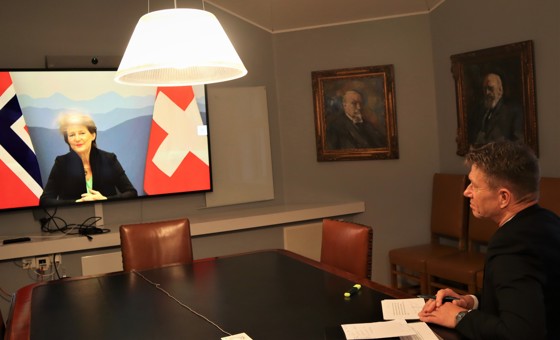Closer cooperation between Norway and Switzerland on CCS
Pressemelding | Dato: 25.11.2022 | Energidepartementet
Norway and Switzerland will strengthen cooperation on carbon capture and storage (CCS) and carbon dioxide removal (CDR). This is clear following today’s meeting between the Norwegian Minister of Petroleum and Energy Terje Aasland and the Swiss Minister of the Environment, Transport, Energy and Communications, Simonetta Sommaruga.

— For CCS to succeed, cooperation across borders is vital. CCS is a key priority for the Norwegian government and has broad political support in Parliament. Longship is a game changer for CCS in Europe and Norway has extensive storage potential. This stakeholder event provides an arena for Norwegian and Swiss actors to come together, share experiences and connect. It is great to see so many important stakeholders engaged in these technologies that will help us ensure a just transition to net zero, says Minister of Petroleum and Energy Terje Aasland.
The Governments of Norway and Switzerland are exploring bilateral cooperation on CCS and CDR. The aim of the stakeholder event is to enhance the understanding between relevant stakeholders in Norway and Switzerland on potential CCS and/or CDR activities.
— Carbon Capture and Storage and Carbon Dioxide Removals are important contributions to climate protection and an opportunity for business and research. CCS should be used where greenhouse gas emissions are difficult to reduce and must not lead us to slacken in our primary goal of rapidly reducing greenhouse gas emissions. I thank all those who are committed to these technologies, especially Norway. I am pleased that our two countries are joining forces in this field and are moving forward together to accelerate cross border cooperation in CCS and CDR, says Minister of the Environment, Transport, Energy and Communications Simonetta Sommaruga.
Norway and Switzerland will strengthen their cooperation on CCS and CDR to reduce and remove greenhouse gas emissions, respectively. An objective of a strengthened cooperation is to promote mutually beneficial cooperation on the development and deployment of CCS and CDR, and further explore other relevant green transition topics for bilateral cooperation.
As part of the dialogue, the two Governments are discussing how to enable cross border market development for CCS and CDR.
Background
Both Norway and Switzerland have ambitious climate and energy policies in place to fulfill our commitments under the Paris Agreement. According to reports from both the IEA and the IPCC, CCS and CDR are a vital part of the solution to combat climate change. Widespread CCS and CDR at the lowest possible cost will be necessary to address hard-to-abate emissions and to achieve the goals of the Paris Agreement.
CCS technologies may help reduce emissions in hard-to-abate sectors and contribute to meeting the high ambitions in relation to the green transition and to achieve net zero emissions. CDR, which permanently removes CO2 from the atmosphere, is necessary to counterbalance any remaining hard-to-abate emissions to achieve net zero emissions.
Norway has more than 25 years of experience with safe storage of CO2 under the seabed with the CCS projects Snøhvit and Sleipner. The safety of storage is confirmed by monitoring programs and reservoir simulations that new projects can benefit from. The Norwegian full-chain CCS-project, Longship, is paving the way for CCS as a crucial tool to decarbonise hard-to-abate sectors. Northern Lights is now building the transport and storage infrastructure in Longship with excess capacity to enable storage of CO2 volumes from other European projects. Other storage projects in Norway are underway.
The Government of Switzerland published a roadmap in May 2022, which specifies how CCS and CDR can be developed progressively to contribute to the Swiss net zero target for greenhouse gas emissions by 2050. The roadmap defines two phases: an initial pioneering phase until 2030 followed by a scaling phase. In both phases, international cooperation is key, since storage potential for CO2 in Switzerland is likely limited. Upscaling of CCS and CDR serve as an opportunity for Switzerland to consolidate its position in research and industry. For example, the partly federally funded demonstration project DemoUpCARMA, run by ETH Zurich in cooperation with other universities and industry, is for the first time demonstrating and optimizing the cross-border transport of CO2, its mineralization underground (in Iceland) and its storage in concrete. This pioneering project aims to gain important insights into feasibility, energy and environmental impacts and scaling issues.